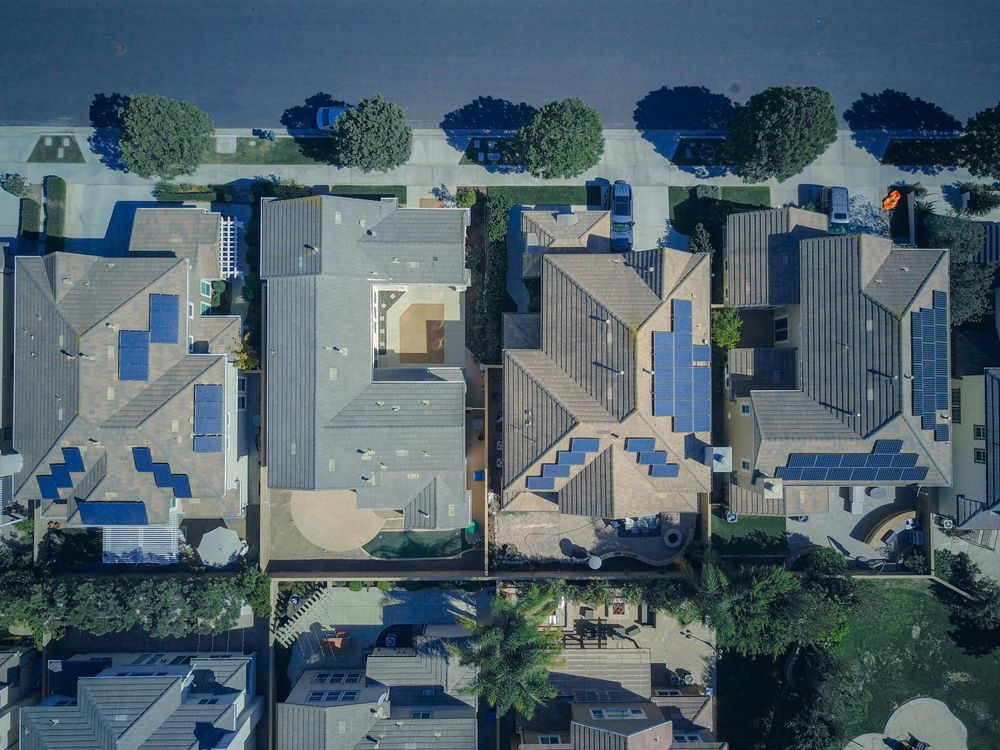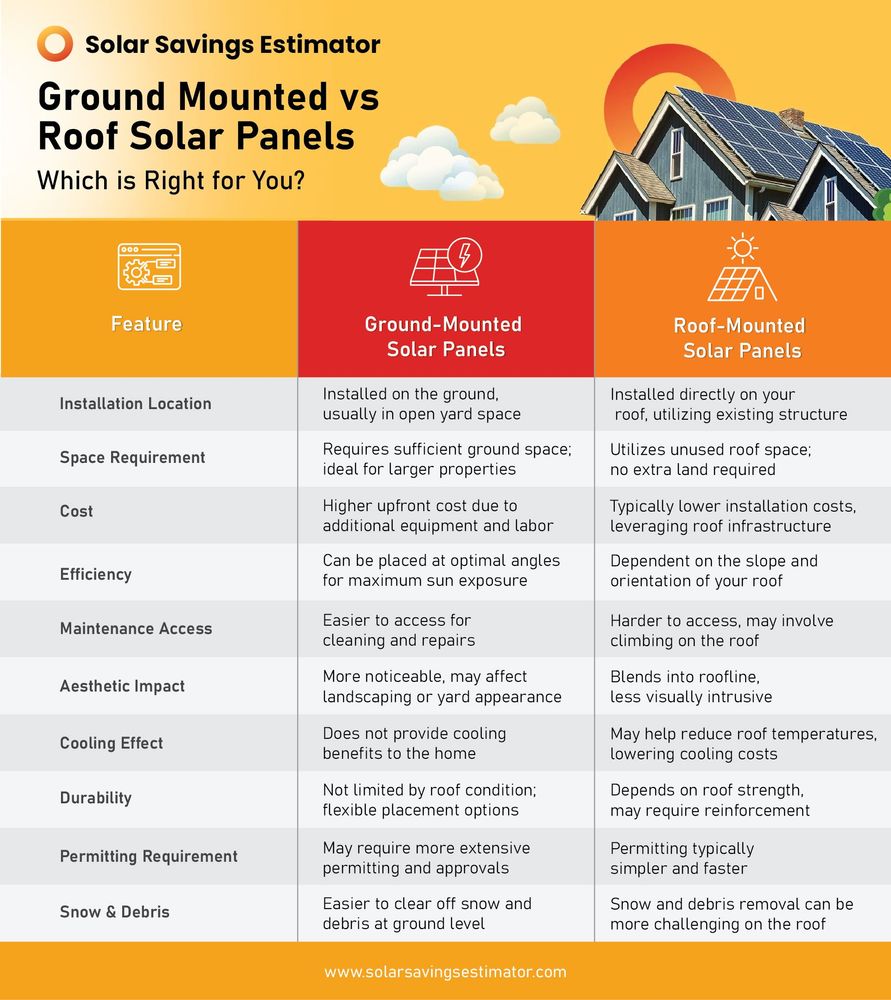Ground Mounted Solar Panels vs Roof Mounted Solar Panels: Which is Right for You?
 Boris Belobrad • 2024-10-15 • 8min read
Boris Belobrad • 2024-10-15 • 8min read
As solar energy becomes more popular, more homeowners are looking for ways to make their homes both energy-efficient and environmentally friendly with solar panels. In fact, solar contributed 67% of all new electricity-generating capacity added to the US grid in the first half of 2024. When deciding between ground- or roof-mount solar panels, it is important to weigh their unique advantages and drawbacks, especially since these factors can affect efficiency, cost, and even how your home looks.

As solar energy becomes more popular, more homeowners are looking for ways to make their homes both energy-efficient and environmentally friendly with solar panels. In fact, solar contributed 67% of all new electricity-generating capacity added to the US grid in the first half of 2024.
When deciding between ground- or roof-mount solar panels, it is important to weigh their unique advantages and drawbacks, especially since these factors can affect efficiency, cost, and even how your home looks .
Before moving into their comparison, it is helpful to first understand what ground-mounted and roof-mounted solar panels are.
Understanding Ground-mounted and Roof-mounted solar panels
Ground-mounted solar panels
Ground-mounted solar panels are installed directly on the ground, typically using a metal framework to hold the panels at an optimal angle for sunlight. These systems are placed in open areas of the property and are not attached to the structure of the building, allowing for flexibility in placement based on available space and sun exposure.
Roof-mounted solar panels
Roof-mounted solar panels are installed on the roof of a home or a commercial building, making use of the existing structure to hold the panels in place. They are designed to fit the slope of roofs, often angled to capture as much sunlight as possible without requiring additional land or space on a property.
What are the pros & cons of ground-mounted solar panels?
Choosing the right solar panel setup can make a big difference in energy savings and long-term satisfaction. Whether you are leaning toward ground-mounted or roof-mounted panels, each option comes with distinct pros and cons worth considering. Let us discuss the pros and cons of ground mounted solar panels first:
Pros of ground-mounted solar panels
- Ideal placement options
- Easier to maintain
- No impact on your roof
Ideal placement options
Ground mounted solar panels give you more control over where you place them. You can adjust the angle and position to capture the maximum sunlight, especially if your roof is shaded or has a tricky design.
Easier to maintain
Being on the ground means these panels are simpler to clean and inspect. If maintenance or repairs are needed, you will not need special equipment or professionals to access your roof.
No impact on your roof
With ground mounted solar systems, you avoid any concerns about your roof’s age, structure, or future repairs. The solar panels will not interfere if your roof needs work down the road.
Cons of ground-mounted solar panels
- Takes up yard space
- Higher installation costs
- Visual impact
Takes up yard space
The biggest drawback is the land they require. If you have limited outdoor space, or you are looking to maintain a garden or play area, ground-mounted panels might be disruptive. They need room, which could mean giving up parts of your yard.
Higher installation costs
Ground-mounted systems often come with more labor and equipment involved in installation. Depending on the layout of your property, this can add to the overall expense.
Visual impact
For some, having solar panels installed in the middle of their yard might be less appealing. While roof-mounted systems tend to blend in more, ground-mounted setups are harder to ignore.
What are the pros & cons of roof-mounted solar panels?
The pros and cons of roof mounted solar panels are-
Pros of roof-mounted solar panels
- Efficient use of space
- Cost-effective installation
- Good for homes with limited land
Efficient use of space
Roof-mounted panels take advantage of unused roof space. This setup makes sense if you do not want to sacrifice your yard for solar power.
Cost-effective installation
Since roof-mounted panels do not require any additional ground preparation, the installation process tends to be quicker and cheaper than ground-mounted options. Your roof is already set up to hold them, and the process is generally straightforward.
Good for homes with limited land
If you do not have much land to work with, roof-mounted panels are often the best option. They sit out of sight and mind, while still providing the benefits of solar energy.
Cons of roof-mounted solar panels
- Roof condition matters
- Harder to access for maintenance
- Less flexibility with positioning
Roof condition matters
One of the main considerations for roof-mounted panels is the condition of your roof. If your roof is old or damaged, it may not support solar panels without repairs or upgrades first. This can add unexpected costs and delays to your project.
Harder to access for maintenance
When repairs or cleaning are needed, accessing roof-mounted panels can be trickier. You might need professional help, which could increase long-term maintenance costs.
Less flexibility with positioning
Unlike ground-mounted systems, roof panels are limited to your roof’s orientation and angle. If your roof does not get consistent sunlight due to shade or its direction, energy production might not be as high as with ground-mounted panels.

Installation locations' best practices: Ground mount vs roof mounts
Selecting the right location for solar panel installation is key to ensuring they work at their best. Here are some best practices to consider for both ground-mounted and roof-mounted systems:
Ground-Mounted Solar Panels
- Sun exposure
- Flat terrain
- Accessibility
- Avoid waterlogging
- Future expansion
Sun exposure
Finding a location with ample sunlight is essential. Look for areas that are free from obstacles such as trees, buildings, or fences that might create shadows. The more sunlight your panels receive throughout the day, the better they will perform. Take a moment to observe the sunlight patterns during different times of the year to choose the optimal spot.
Flat terrain
Opt for a flat area if possible. This simplifies the setup process, allowing you to angle the panels perfectly for maximum sun exposure. If your yard is sloped or uneven, some leveling may be necessary. Consider consulting with a professional to ensure the site is prepared correctly.
Accessibility
Choose a spot that is easy to reach for maintenance and cleaning. Ground-mounted systems tend to be more accessible, but consider the path you will take to access the panels. Clear paths make routine checks more convenient, which means you are more likely to keep up with maintenance tasks.
Avoid waterlogging
It is also important not to sit, lie, or travel to areas that tend to have water stagnation. A puddle of water beneath your solar panels can cause a variety of problems ranging from structural failure to decreased energy production. Make sure you dry environments for your installation to retain its condition as time passes.
Future expansion
If you think you may want to expand your solar system later, leave extra space for additional panels. Ground-mounted systems are typically flexible, so planning for future additions can save you hassle down the line.
Roof-mounted Solar Panels
- Orientation
- Roof angle
- Shade check
- Structural integrity
- Accessibility for maintenance
Orientation
The orientation of your roof greatly affects how efficient your solar panel is. Indeed, the optimum exposure includes south-facing roofs that can get the highest irradiation, while east and west-facing roofs would perform if properly exposed. Do not invest in rooftop solar panels for the north-facing side because, in most cases, the side faces minimal direct sunlight.
Roof angle
The angle of your roof also affects how effectively solar panels can operate. Roof mount systems with a steep angle may require different mounting options, so ensure your installer is equipped to handle that. A pitch around 30 degrees is often considered ideal for capturing sunlight efficiently.
Shade check
Before installation, assess your roof for any shading from nearby trees or structures. Even minor shade can significantly reduce the efficiency of your solar panels. If possible, trim any overhanging branches or remove obstacles to keep your panels fully exposed to the sun.
Structural integrity
Inspect your roof's condition before proceeding with solar panel installation. An old or damaged roof may need repairs to support the additional weight of the panels. A solid roof not only provides the necessary support but also helps to prolong the lifespan of your solar system.
Accessibility for maintenance
While roof-mounted panels can be trickier to access, it is important to plan how you will maintain them. Consider whether you need to hire professionals for routine cleaning and checks, as some roofs may require ladders or specialized equipment for safe access.
Comparison: Ground Mounted Solar Panels vs Roof Mounted Solar Panels
Below table will help you to evaluate which option better suits your home and personal preferences:

Wrapping up
In conclusion, it can be noted that the installation of ground-mounted and roof-mounted solar panels has its advantages and disadvantages. The benefits of each should be weighed against your own requirements, the amount of space available in the facility, and the funds required to purchase one.
In sum, regardless of which of the two options is chosen, opting for solar systems is a renewable and cheap method of power use in the house that has negligible effects on the environment. Think about your energy goals, space, and budget to decide which option works best. You can also consult a solar expert to get personalized advice for your needs.